Wednesday Walk: Who Needs Radio Shack?
Finding exactly what I need at a local retailer, my grandpa's first radio, and another vintage Sears shirt
Welcome to Willoughby Hills!
If you enjoy what you’re reading, please consider a free subscribtion to receive emails every Wednesday and Sunday plus podcast episodes every two weeks. There are also paid options, which unlock even more features.
As is typical every Wednesday, I’m bring you a smattering of topics that I hope will make you a bit more curious about the world around you and give you something to think about later. I call these Wednesday Walks, as it’s the type of conversation we might have walking down a path in the woods. Shall we take a stroll?
A Local Plug
My daughter has wanted to get into voice acting for quite some time although it hasn’t been something that we’ve actively pursued. We haven’t cut a demo reel, hired an agent, or even looked at possible auditions.
But recently, a friend suggested that our daughter might be a good fit to voice the book Meet Maya Cat, which is going to be animated. The author, Lauren Beader, was a friend of the friend and our daughter met with her to see if this project worth pursuing.
The meeting went well and our daughter was cast for the part. She read the book from our home “studio” that I use for recording the podcast, with Lauren joining via Zoom to give direction.
I acted as the engineer for the session, although the night before the recording, I realized that I was short one weirdly specific part. Without getting too in the weeds, I needed a headphone adapter that would allow my daughter and I to both simultaneously listen to the feed from my mixer (specifically a 1/4” to 1/8” adapter).
If this were 10 years ago, Radio Shack would have had the part, although our local Radio Shack, and most of the remaining locations, closed in 2017.
I was in a bit of a panic. It was 7:30pm at night and the recording session was at 10:00am the next morning. There wouldn’t be time to ship a part from Amazon or B&H. I would have to find it in a brick and mortar store locally.
I tried Best Buy’s website. They had the part in stock, but not at any of the stores closest to me. I would have to drive at least 30 minutes to get it and I might not make it to the store before closing time. Target didn’t have anything close in their online inventory. Neither did Wal-Mart.
I decided to start searching online for local electronics stores and had completely forgotten that there was one not far from me in Littleton, MA. They were closed for the evening but opened at 9am the next morning, which would give me time to get the part and get home before the recording started.
Electronics Plus is unassuming from the outside. It sits between a small Asian grocery store and a vinyl records store.
The inside is a bit cluttered, with walls of pegboard covered with every kind of cable, relay, and plug imaginable. It reminds me of the rear aisles of Radio Shack back in the day- every little speciality part imaginable, but none of the cellphones, radio controlled cars, or electronic keyboards that would have populated the front half of Radio Shack.
When I visited the store, I told the clerk what I needed and he led me to a back corner where there were literally three or four different versions of what I needed: stereo, mono, gold-plated, etc.
The part that I needed cost $3.49 plus tax. I selected it, and then took a lap around the store. Sadly, I didn’t need anything else on that trip, because I wanted to support this amazing local business and keep it viable, but I suppose even my $3.00 helped in some small way.
There was something so transportive about being surround by RCA cables, soldering irons, and circuit boards. It reminded me of my high school days when I produced a public access show and Radio Shack was my only dispatch from the larger world of TV and video. My friends and I used to obsess about the new microphones and XLR cables that would come in, not yet discovering pro audio and video shops.
The sign on the door says that Electronics Plus is celebrating 30 years in business. On the one hand, I hope that a quirky local store is able to survive another 30 years, but I also know that can’t happen one small transaction at a time. Still, for as long as it hangs in, Electronics Plus is quite the gem.
It was a reminder that oftentimes big chain stores meet their demise for factors beyond just the economics of supply and demand. Debt load from a merger or acquisition, high overhead from running a massive corporation, or investing in a brand initiative that doesn’t pay out can have a much bigger effect on a large chain than a little mom and pop store. It was also good to remember that shopping locally doesn’t have to be done for charitable or ideological reasons. Sometimes the local shop just does things better than the chain, in this case, simply by surviving.
By the way, if you want a nostalgic blast from the past, check out Electronics Plus’s website, which was created in 2003 and had very few updates since then!
Speaking of Old Radios
On Sunday, I wrote about my grandpa and the Chevy Caprice Classic that he drove when I was young. Ever since writing that piece I’ve been thinking a lot more about my grandpa and all the questions that I have for him that he can no longer answer since his passing more than a decade ago.
We are fortunate that he was a professional photographer and spent a lot of time and effort documenting our lives and the lives of our relatives (including archiving a lot of old photos so we would have them in the future). He also happened to be a writer, and when I write more personal pieces like the one from Sunday, I can really feel the effects of him on me.
In his later years, he did a lot of writing of Good Old Days, a magazine that celebrates nostalgia. I have hard copies of a lot of his writing somewhere, but my mom was able to find a digital copy of one of his writings titled “Our First Radio,” which was reprinted by the Modesto Radio Museum.
In the piece, my grandpa describes growing up in the oil fields of Oklahoma, migrating to California’s Central Valley as a young boy, and accompanying his mom into the city of Modesto to buy necessities at Montgomery Ward after she received a large paycheck from some seasonal work.
The details in my grandpa’s story bring to life a part of him that I never knew and never imagined. He talks about growing up without electricity, hearing a radio for the first time in his older brother’s Ford, and how his mother unexpectedly bought a radio for the house on that shopping trip to Montgomery Ward:
“A salesman tried to sell her a big floor model, but she said she didn’t have enough money for such as that. He worked his way down and finally showed her one that would suit. He said it was a table model, but a rather large table model to accommodate a large speaker for good music tones. It was the Airline Deluxe, with eight-push-button tuning. It really was beautiful in its highly polished, walnut-finish cabinet with lighted dial and brass trim around the dial and push buttons.”
I loved the vivid way that my grandpa could describe an item from his childhood that was six or seven decades in the past at that point. I was curious if any radios like the one he described survived and through the strange magic of the internet, I was able to find a very similar radio that he bought that day selling for about $100 on eBay!
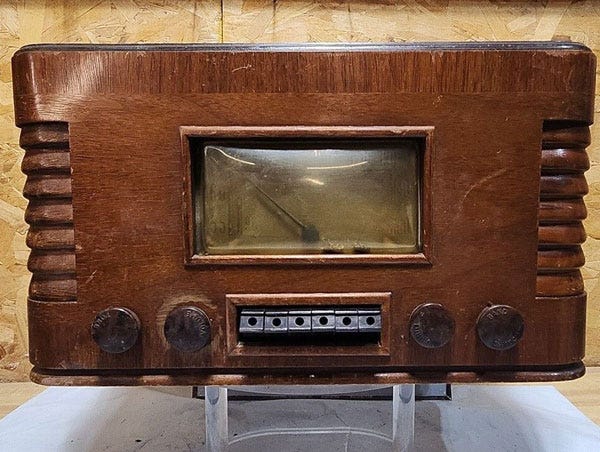
According to the eBay listing, this unit is from 1941 when my grandpa would have been roughly 13 years old, so I suspect his was likely an earlier model. It only has six buttons for tuning, not the eight he described, and there’s not the brass trim he mentioned, but it’s a Montgomery Ward Airline radio from the same time period.
A part of me has the urge to buy this and try to restore it, but I don’t know the first thing about rebuilding radios. Or maybe I would just gut the inside and use the cabinet as a fancy display for a modern speaker with bluetooth connection to my phone. Either way, there’s something poetic to me about recreating something from my grandpa’s childhood and making it useful in this time.
If I ever decide to attempt a restoration like this, at least I know a good source for electronic parts now!
#NoNewClothes- Week 29
Last week, I wrote about “breaking” my No New Clothes challenge by buying a vintage Sears sweater from a thrift store. And yes, breaking is in quotes because it was only a semi-breaking of my goal.
Since this challenge is really about mentality and there’s no reward other than internal validation for the project, it’s hard to say whether or not buying a 40+ year old sweater was really a breach. After all, it wasn’t new, although another goal that I’ve stumbled upon is to buy less overall and to be a more conscious consumer.
I am happy to report that I resisted the urge to buy another vintage Sears piece this week while visiting a local thrift store. And here’s the crazy part- it was probably 45 years old or more and it looks like it was never even worn!
The shirt was a short sleeve blue cotton-poly button up shirt, likely from the 1970s, although tough to date from the tags. It had a tag attached to one of the buttons and shirt pins still in the lower half, making it as fresh on the rack at Savers as it would’ve been at Sears.
The fact that I’ve been writing so much about Sears lately certainly has given the chain a special place in my heart. There’s something to me that’s so alluring to me about clothing from a nearly dead retailer that was once so large and influential. The fact that these clothes still look and feel good decades later is a nice bonus.
So why didn’t I buy this one? As I mentioned last week, one of my rules for buying new (or used) clothes at this point is that they have to be impeccable- the right fit, the right color, and the right style for me. This one checked two of the three boxes, but the fit just wasn’t right, at least not for 2023.
The shirt had very long tails and seemed designed to be tucked in. I could see a high school teacher in the 1970s wearing this with a necktie in the biology lab, but to me, it’s more casual and would certainly never be tucked in.
The very long tails also had writing printed on the outside. I don’t remember this being a thing- was that normal back in the day? Considering that this shirt didn’t seem to have been worn, I wonder if that writing was designed to be washed out in the washing machine or was it meant to be hidden when tucked in?
I am a sucker for vintage Sears clothing like this (I have maybe 2 other pieces that I’ve happened upon in years past that are currently in my closet), but this one remained on the rack for somebody else to purchase.
And by the way, if you haven’t been following along with this No New Clothes challenge, it was inspired by a newsletter I wrote about Amory Sivertson, who did a similar challenge last year.
Thank you for reading! Did you get something out of today’s issue? I always love hearing your thoughts, so please drop a line in the comments.
I publish new issues every Wednesday and Sunday. Sign up to always receive the latest issue and support my work:
Other Wednesday Walks
If you’ve missed past issues of this newsletter, they are available to read here.


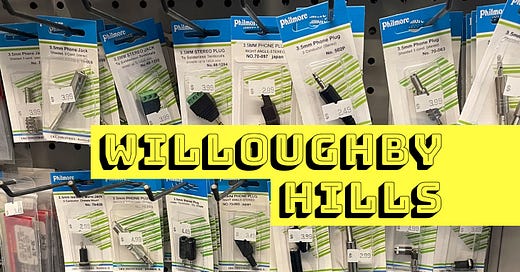


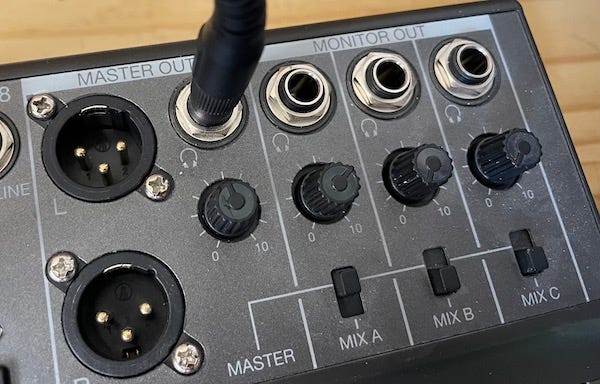
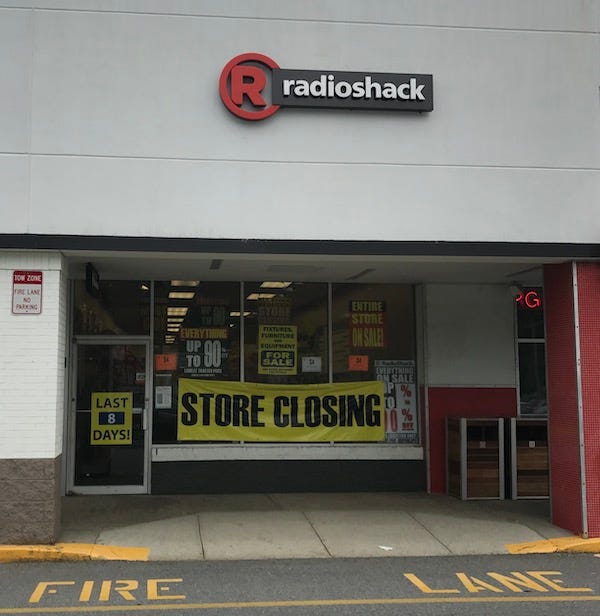
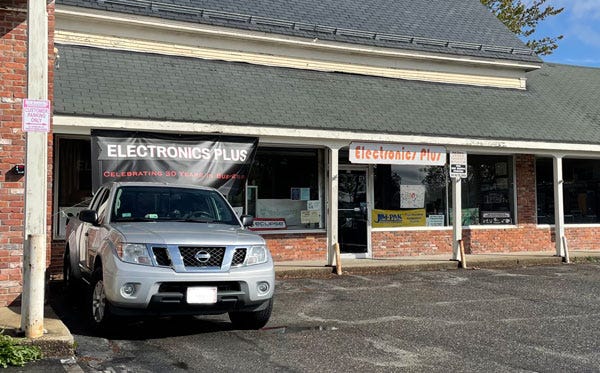


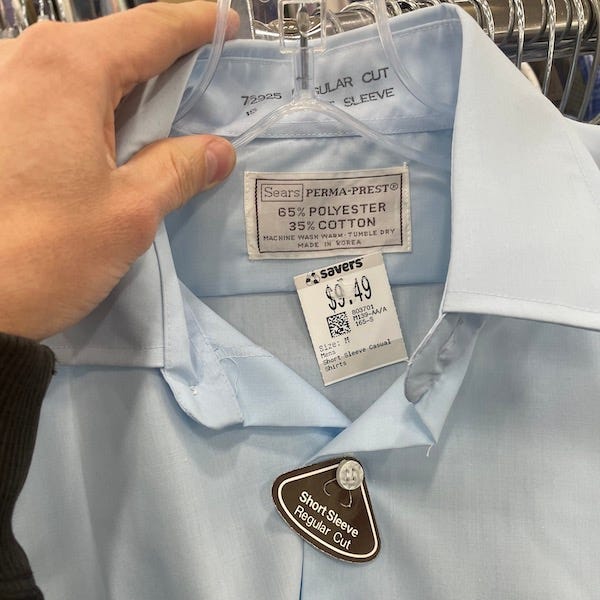
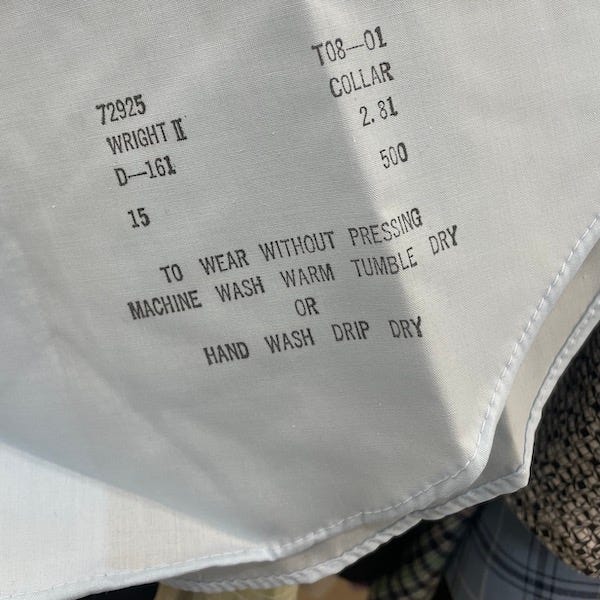
Heath, I grew up not far from you in S. Euclid OH. Our shopping area was Cedar Center. We lived one block over. The shopping center was on both sides of Cedar Rd. We moved there because my Mom never drove, and there was a grocery store, 2 delis, a bagel shop, movie theater, barber shop, bowling alley, and much more, including a Radio Shack. They had a battery club, where you could get a pack of batteries each month. I would make time to get my pack every month whether I needed them or not. https://radio.drewdurigan.com/classic-vintage-products/battery-of-the-month-club/